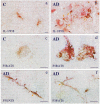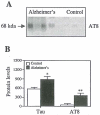Interleukin-1 promotion of MAPK-p38 overexpression in experimental animals and in Alzheimer's disease: potential significance for tau protein phosphorylation
- PMID: 11578769
- PMCID: PMC3833633
- DOI: 10.1016/s0197-0186(01)00041-9
Interleukin-1 promotion of MAPK-p38 overexpression in experimental animals and in Alzheimer's disease: potential significance for tau protein phosphorylation
Abstract
Activated (phosphorylated) mitogen-activated protein kinase p38 (MAPK-p38) and interleukin-1 (IL-1) have both been implicated in the hyperphosphorylation of tau, a major component of the neurofibrillary tangles in Alzheimer's disease. This, together with findings showing that IL-1 activates MAPK-p38 in vitro and is markedly overexpressed in Alzheimer brain, suggest a role for IL-1-induced MAPK-p38 activation in the genesis of neurofibrillary pathology in Alzheimer's disease. We found frequent colocalization of hyperphosphorylated tau protein (AT8 antibody) and activated MAPK-p38 in neurons and in dystrophic neurites in Alzheimer brain, and frequent association of these structures with activated microglia overexpressing IL-1. Tissue levels of IL-1 mRNA as well as of both phosphorylated and non-phosphorylated isoforms of tau were elevated in these brains. Significant correlations were found between the numbers of AT8- and MAPK-p38-immunoreactive neurons, and between the numbers of activated microglia overexpressing IL-1 and the numbers of both AT8- and MAPK-p38-immunoreactive neurons. Furthermore, rats bearing IL-1-impregnated pellets showed a six- to seven-fold increase in the levels of MAPK-p38 mRNA, compared with rats with vehicle-only pellets (P<0.0001). These results suggest that microglial activation and IL-1 overexpression are part of a feedback cascade in which MAPK-p38 overexpression and activation leads to tau hyperphosphorylation and neurofibrillary pathology in Alzheimer's disease.
Figures







References
-
- Braak H, Braak E, Strothjohann M. Abnormally phosphorylated tau protein related to the formation of neurofibrillary tangles and neuropil threads in the cerebral cortex of sheep and goat. Neurosci. Lett. 1994;171:1–4. - PubMed
-
- Du Y, Dodel RC, Eastwood BJ, Bales KR, Gao F, Lohmuller F, Muller U, Kurz A, Zimmer R, Evans RM, Hake A, Gasser T, Oertel WH, Griffin WST, Paul SM, Farlow MR. Association of an interleukin la polymorphism with Alzheimer’s disease. Neurology. 2000;55:480–483. - PubMed
-
- Goedert M, Jakes R, Vanmechelen E. Monoclonal antibody AT8 recognizes tau protein phosphorylated at both serine 202 and threonine 205. Neurosci. Lett. 1995;189:167–170. - PubMed
Publication types
MeSH terms
Substances
Grants and funding
LinkOut - more resources
Full Text Sources
Other Literature Sources
Medical

